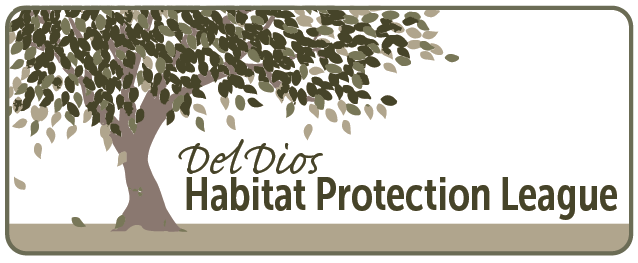Phase 3 of the Hodges Watershed Restoration has begun
Target Species: Eucalyptus, Pampas Grass and Tamarisk.
Plantings with the winter rains: Sycamore, Oaks, Mulefat, Willow.
Invasive non-native plants are threatening the ability of the San Dieguito River and watershed to function properly. Many non-native plants contribute to flood damage, are a fire risk and degrade native habitats. The Del Dios Habitat Protection League is working in partnership with the San Dieguito River Park to help restore the natural functions of the river. An action that enhances watershed health is the control of non-native plants. The seasonal watercourses and lakeshore of Hodges reservior provide valuable habitat for native flora and fauna that is a cornerstone for our incredible biodiversity of the region.
Along the new lower level of Hodges reservior, cat tails and bulrushes have established as well as willows directly above this level. This is much the same as what these species do along a natural river. Several locals have expressed concern to the League about the invasion of Pampas grass and Tamarisk that is also moving into these same areas.
Phase 3 of the Oak Woodland Restoration and Fire Fuel Reduction Project will include the establishment of native plants as well has removal of non-native invasives, such as Tamarisk, Pampas grass and Eucalytpus.
This work is sponsored by the NRCS and is the result of partnerships with numerous local agencies, including the City of San Diego Public Utilities Department, the San Dieguito River Park and the Del Dios Mutual Water Company.
Establishment of native species is scheduled to start with the first rains in areas where eucalyptus has been removed. We look forward to working with weekend volunteers planting acorns, pole cuttings and potted native plants.
Pampas Grass
According to the California Invasive Plant Council, pampas grass creates a fire hazard with excessive build-up of dry leaves, leaf bases, and flowering stalks. In addition, pampas grass out-competes native vegetation, by propagating easily and growing rapidly.
Tamarisk (Salt Cedar)
Tamarisk is the other species of high concern that is taking over a large swath of the 'bathtub ring" below the high waterline of Lake Hodges. Tamarisk that has a long history in the west for out competing native willow habitat and poisoning the soil to keep other plants from growing in the same areas with it. The plant is also called Salt Cedar.
Phase 3 will include removing tamarisk and pampas grass and planting willows at Green Lagoon (second parking lot from the gates at Lake Dr) and other prime locations to encourage the Southwestern Willow Flycatcher (endangered, federally listed songbird) to come live and breed here at Lake Hodges.
Make sure to look for volunteer opportunities with the winter rains to help with the planting. Become a member of the Del Dios Habitat Protection League.

